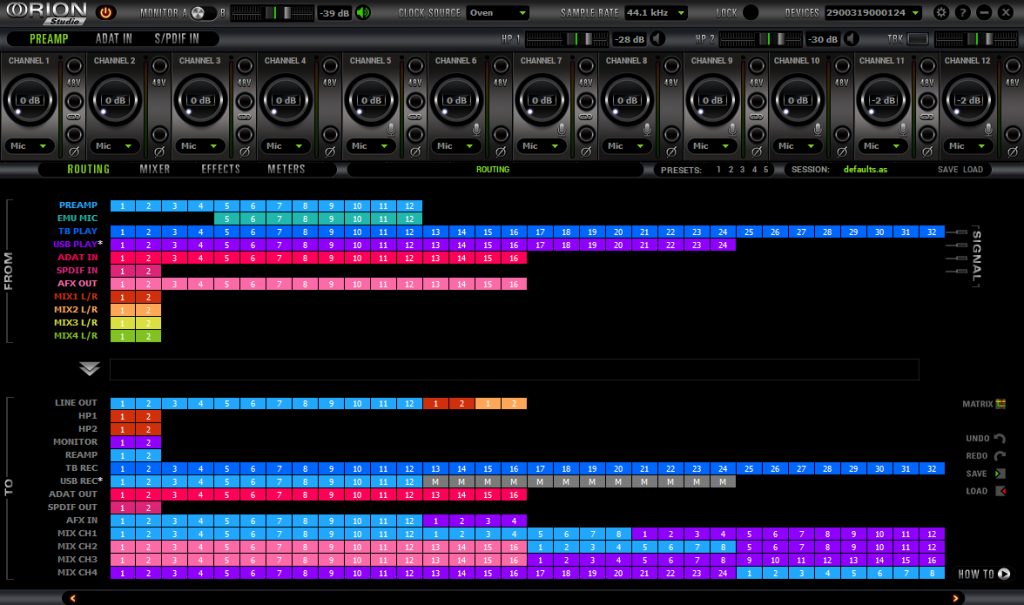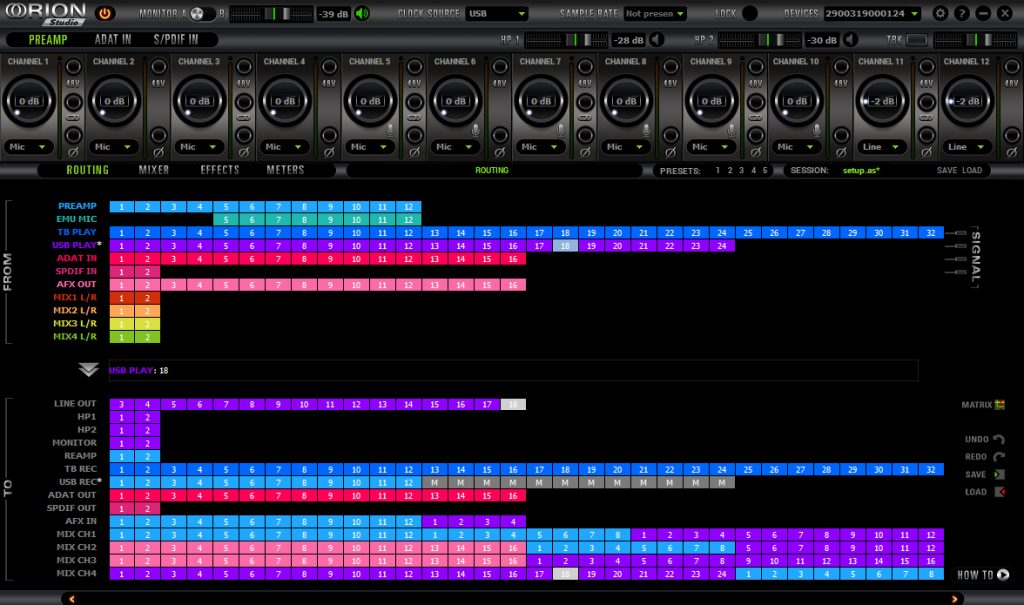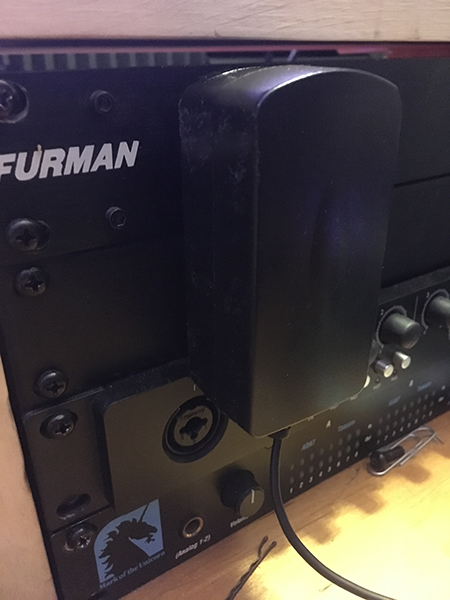
By Lilian Blair
When it comes to working in digital audio, the converter is the key component in making the whole thing work. Everything that can play digital audio, from your phone to your laptop to those musical gift cards has within it a converter, which translates the voltage of an analog audio signal into binary digital information, and vice versa. Typically, the converters in your everyday electronics are at the lower level of quality and cost. Most consumers, if, say, you’re listening to Spotify over your stock iPhone earbuds, aren’t going to notice or need higher quality components, which may not even fit in their phones to begin with, and that’s fine. As long as the listener enjoys the listening experience, it doesn’t matter if they’re listening to lossy files over cheap headphones and cheap electronics. For audio professionals (and audiophiles), however, every piece in the signal chain can have a great impact on the quality of the signal, both going in and going out, and your converter is no exception.
In one’s pro audio journey, your entry level audio interface is going to run you a couple hundred dollars. It’s going to be external, as the converters in your computer are susceptible to interference from the other internal components. Your features are going to be limited to one or two preamps, and a couple outputs for monitors, and all that is excellent. You don’t need any more functionality until you’re ready for it, and great records are made every day using your entry level audio interfaces. But, in addition to functionality, the quality of the internal components drastically affects the quality of both your incoming and outgoing audio signals. A two channel interface that costs $200 compared to a two channel interface that costs $1000 has to justify the difference in more than brand name.
As part of my mixing process, I stem out my session into 16 channel summing mixer and bring that back into my DAW for playback and bouncing. It changes the sound in a way that I like, but in order to use it to its fullest capacity I need more features on my interface than I’d get from a two channel desktop box. After getting the summing mixer, my solution was to connect an old eight channel MOTU to my Scarlett 18i20 over ADAT. The problem with this method was that I couldn’t utilize all the Scarlett’s outputs (since the headphone outs share circuitry with some of the outputs, meaning I wouldn’t be able to use headphones if I wanted to use all my outputs). Additionally, the MOTU was partially busted. This was the second MOTU I’d purchased for this purpose, and the other one had the exact same problem (while this is not a MOTU review, maybe skip picking up any used 2408s). It had a widely different voltage coming out of the even channels than the odds, with some channels not even working. Yuck. I ended up being limited to 10-12 outputs, depending on whether or not the MOTU was acting up, and had to adjust the gain out my outputs in Pro Tools to make sure the signal going out of my outputs was even. Sometimes having to add more than 6dB to my output, which ate up my digital headroom.
Tired of my barely functional system, and not being able to use my summing mixer to the fullest of its capabilities, I decided to research alternatives. My goal was to be able to send out 16 channels of audio at 96kHz/24bit. I was expecting to have to buy two units, as most rack mounted interfaces provide only eight line outs. I was thinking of buying two new Scarlett 18i20s, but, while lazily browsing Reverb, I stumbled upon the Antelope Orion Studio. I’d already had experience with Antelope’s Orion 32, and knew of their quality and reputation. Antelope is one of the premium manufacturers of audio interfaces, converters, and wordclocks. They’re one of the companies whose equipment you aspire to own as you build your studio and your career. Also, this particular unit has 16 channels of line outputs over DB25! I can get all the functionality that I want and free up a rack space! So, after pricing my options, settled on a used Orion Studio rev 2017.
Let’s go over the functionality of the unit. The Orion Studio is meant to, as its name suggests, provide a wide variety of studio functionality in a single unit. It has the aforementioned 16 analog outputs, as well as 12 mic preamps (compared to your typical eight). The mic pres are XLR/TRS combo jacks, and the TRS connection can be switched to an independent line in circuitry, which means I don’t have to run my signal going back into Pro Tools through a mic preamp, like I had to with the Scarlett! The front four (compared to the more usual 2) inputs also serve as DIs. The two headphone outs are completely independent of the other line outs. It has two reamping outs, and I don’t think I’ve seen another comparable interface that has reamping outs. There’s a built in talkback mic, and it can support 16 channels of i/o over ADAT, meaning, when connected over Thunderbolt (USB is more restricted) you can have a whopping 28 inputs and 32 outputs, at 48kHz/24bit. There’s also SPDIF but I don’t care about that. When they say studio, they really mean studio. With a couple extra converters, you can run at a track count that almost matches what most professional studios run with, and you don’t even need an expensive mixing board!
Of course, most of that functionality, for me, is superfluous at the moment. All I want is my line outs, and the other things Antelope are known for: their converters and their wordclock. Now, I’ll admit, I have no idea what to listen for when it comes to a wordclock, so I’m falling back on the adage that more expensive equals more good. Converters, though, are easy to tell the difference between. All you need to do is have two bounces and do a quick A/B, or null test. When doing that comparison, I was blown away. Now, without someone else to switch between tracks, I couldn’t do things completely blind, so my brain absolutely was looking for a justification for all that money I’d just spent, so I tried to focus on the differences rather than what I preferred. The first thing I noticed was that the Antelope felt clearer and richer than the Scarlett/MOTU. In comparison, the Scarlett/MOTU sounded like it had a dull patina over the sound. It didn’t sound bad, just more muted. I could also hear more separation on the Antelope bounce than on the Scarlett, which is good. It gives me more flexibility with my mix. I don’t have to work harder to try and achieve that higher end sound, which means I don’t have to do as much potentially destructive things in my mix. Finally, I did a different stemming configuration to be able to use all of the inputs on my summing box. The difference between this bounce and the previous Antelope bounce was more subtle, but I did get an additional bump of separation, since each of the input circuits didn’t have to handle as much voltage as before (Ok, I don’t exactly know what the technical reason is, if you do know, please comment and I’ll make the necessary edits). From a sound and functionality perspective, I couldn’t be happier with my purchase, and fully expect this unit to last me for years.
But enough with the good, let’s talk about the stuff that pisses me off.
Getting this thing up and running was sooooo annoying. Hooking up the cabling was fine, but getting the software to do what I wanted it to do was a nightmare. A lot of interface companies seem to be including their own routing software that you have to use in conjunction with your DAW in order to get things to work the way you want to. Antelope seems to have taken this to the extreme. The first hurdle is actually figuring out how their routing actually works.
Look at this screen:

Here’s what it starts up at. Can you figure out why I’m not getting any signal coming out of my analog outputs?
In order to get it to work like it should work right out of the box, with the outputs from Pro Tools going to the ouputs in the unit, is to drag, individually, the outputs from USB (or TB) Play to my line outs.

It took me a good while to figure this out, as the manual was not particularly helpful. The Scarlett’s software, by comparison, is straightforward and defaults to what you want it to default to. The Antelope control panel also has not one but four different mixers, as they want you to premix in their software before sending things to your DAW. The plus side to the mixers is you get zero latency for your musicians. The downside is that you still have to play back from your DAW for overdubs, so you’re still dealing with latency, and if that’s the case, why not just do your headphones in your DAW? The Antelope already has super low latency, since they designed their own USB chipset, and can run over Thunderbolt too. I’m sure some people, under duress, would use their mixers, but I can’t think of a situation where I’d ever want to.
As with most of these higher end interface companies, they also include onboard signal processing for high quality plugins. That sounds amazing, I love new plugins, and it looks like the Antelope has some models that I don’t already have. Unfortunately, I have to load the plugins in their app, and, again, ugh. This would mean I’d be using two DAWS, having to save and load two different sessions, remember which processing happens where, and dealing with the limitations of having to split out that processing. What if I want to use an Antelope compressor on my drum bus, followed by an EQ that I only have in my DAW? Not possible, for me at least. Antelope does have a way to do that. If you spend $200 on their AFX2DAW plugin, you’re able to load their plugins into your DAW like any other plugin. As long as you do it over Thunderbolt (I’m using USB), and as long as you have a Mac (I use Windows). The manual for the 2017 studio says that they are working on a Windows version of this plugin, but now, going on four years later, I’m seeing nothing about a Windows version. And if I decided to suck it up and use their plugins in their software, I’d have to drag each out my outputs to their AFX in slot, and then the AFX out slots to my line outs. This is neither fun, nor easy. Neither intuitive, nor convenient. It feels like the software was designed without any user interface designers involved. All function but no attention put towards ease of use, especially for people who haven’t, say, spent years either developing or working with the software. Oh, and because I’m on the previous generation, I can’t use any new plugins that they release. So that’s nice. I have to spend thousands every couple years just to use a couple new models? I think I’ll stick to my in the box processing.
Other things to note:
The unit comes with an external AC adapter. It’s a wall wort (ugh), but look at this thing…

Notice anything stupid? It extends a whole 2U beyond it’s plug! And with how short power conditioners are, if I wanted to plug it into the back of my Furman, I’d be sacrificing two rack units of space! And with my racks built into my desk, space is precious! I ended up hooking it up using a two prong extension cord, which is ugh. Now the adapter lays on my floor, like any other in line AC adapter. Which is probably what they should have gone with to begin with. Again, all thought for the design, none for actual usability.
Also bear in mind, this unit runs HOT!!! The operating temperature is between 32 degrees and 122 degrees Fahrenheit, so it can take the heat, but I’m shocked at how warm it actually is. Even just doing playback, it’s pretty hot, but when I’m running all 16 outs, it’s really cooking. I’d initially installed it over my summing box, which looked nice and was convenient, but when I went to adjust the volume I almost burned my fingers. The summing box runs hot too, and all that heat was going into the Antelope. I moved it, since not only do I not want to hurt myself while using it, but heat degrades the quality and longevity of electronics. Bear that in mind when you choose your installation location. Either give it some extra space, or make sure you put cooler units below it.
So where does that leave us? High learning curve at setup, unusable plugins, and a whole bunch of features that I have no use for. So am I happy with my purchase? Absolutely! The quality alone is worth the cost, and it has the functionality that I actually want and need, the 16 analog line outs, and I haven’t found any other unit that gives me this (Ok, there was a MOTU, but getting that new would have cost more than getting the Antelope used, and I’m mad at MOTU, having had two of their older units crap out on me. I want this to last me long enough that the cost is worth it, and I just don’t trust MOTU to give me that). Sometimes, you’ve got to put up with a lot of annoyance and pay for a lot of unneeded things in order to get what you actually want. And once I figured out how to get everything set up the way I want it to be, then I don’t have to think about or even open Antelope’s software every again, which is probably my favorite feature so far.
Should you buy? I haven’t found another 1U self-contained unit that offers this level of functionality and expandability at this price point (especially when you buy it used like I did). If you need this level of functionality, expect to open a home or lower end professional studio, then go for it! If you don’t need what this unit offers, Antelope sells a range of products, from smaller desktop boxes to higher end units that can handle whatever a professional studio throws at it, and the money you spend is going towards some of the best internal components (the things that really matter) in the business. Just make sure you make yourself a cup of calming tea and grab a stress ball as you set it up.

Lilian Blair is a producer, engineer, and audio educator in the Seattle area. She specializes in studio recording, mixing, and helping artist achieve their musical dreams.


